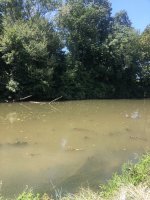It is what it is at this point. Lower Hammer will always be what it is. People insisted on their lake front property....I suggest enjoying the Smallmouth in the warm months, and that pond-great largemouth fishing.
The Upper Hammer could, and should be, a lot more than what it is. And McSneek's reports should not be ignored. Before moving to WV, I fished upper Hammer a lot. I've caught some of my largest brookies to date up there. This year, on a trip back to Lanc, I fished it 3 days, all in ideal conditions. Only a few deep holes really produced fish, and it was brownies 3 to 1. Now, I've had bad days on it before moving down here, so taken by itself, I would think nothing of it. But combined w/ what McSneek is experiencing, as well as a few others I've spoken to, SOMETHING is off...It does suffer from pressure and harvesting in the Spring thanks to the State continuing on insisting it get stocked. I've personally seen stringers full of both native and stocked fish on many, many occasions. But that's been true for a long time. Something else may be happening...





